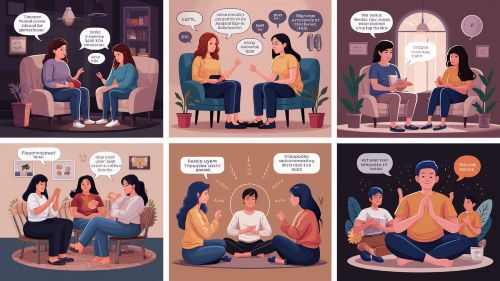The decision to start therapy for postpartum depression (PPD) is a monumental act of courage. But with that decision often comes a wave of new questions and anxieties. What will it be like? What will I even talk about? Will I have to lie on a couch and talk about my childhood?
If you’re considering Cognitive Behavioral Therapy (CBT), one of the most effective treatments for PPD, you can put those old-fashioned images aside. CBT is a practical, present-focused, and empowering approach that feels less like a mystery and more like a skills-building workshop for your mind.
But starting anything new when you’re already exhausted and overwhelmed is tough. That’s why we’ve created this gentle guide. We’ll walk you through exactly what to expect from CBT—from the first session to the last—so you can step into your recovery journey with clarity, confidence, and hope.
First, What is CBT in Plain English?
Before we walk through the door, let’s look at the map. CBT is based on a simple but life-changing idea: our thoughts, feelings, and behaviors are all connected. It’s not necessarily a situation that makes us feel a certain way, but our thoughts about the situation.
This is the “CBT Triangle”:
[Insert a simple, clear infographic of the CBT Triangle here. It should have “THOUGHTS” at the top, “FEELINGS” at one bottom point, and “BEHAVIORS” at the other, with arrows flowing between all three.]
In PPD, this creates a powerful downward spiral. For example:
- Situation: The baby fusses while you’re trying to put them down for a nap.
- Thought: “I’m failing at this. A good mom would be able to get her baby to sleep.”
- Feeling: A surge of shame, frustration, and hopelessness.
- Behavior: You give up, feel paralyzed, and retreat into yourself.
CBT teaches you how to interrupt this cycle by giving you tools to change your thoughts and your behaviors, which in turn changes how you feel.

The Journey: What to Expect from Your CBT Sessions
CBT is a structured journey with a beginning, a middle, and an end. Here’s a look at the roadmap.
The First Session: The Intake
The first one or two sessions are all about setting the foundation. This is often called the “intake” or “assessment.” The anxiety is usually highest here, so know this: the goal is not to “fix” you. The goal is to get to know you.
What you can expect:
- Building Rapport: Your therapist’s first job is to create a safe, non-judgmental space. They want you to feel comfortable.
- Telling Your Story: They will ask you to talk about what brought you to therapy. You don’t need a perfectly rehearsed speech. You can just say, “I’m not feeling like myself,” or “I’m so anxious all the time.”
- Gathering History: They will ask questions about your pregnancy, your birth experience, your support system, your sleep, and your symptoms. They’ll also ask about any previous history of depression or anxiety. This helps them get a complete picture.
- Setting Goals: This is a key part of CBT. The therapist will ask, “What would you like to be different?” or “If therapy is successful, what would that look like for you?” Your goals can be simple: “I want to enjoy my baby,” or “I want to stop feeling so guilty.”
You don’t need to have all the answers. Your therapist is your guide. They will lead the conversation. Your only job in the first session is to show up and be as honest as you can.
The Early Sessions: Building Your Toolkit
Once the foundation is set, the work begins. But “work” in CBT is empowering. You’ll start learning the core skills to challenge PPD.
Expect to learn about:
- Psychoeducation: Your therapist will teach you about the CBT model (the triangle) and about PPD as a medical illness. Understanding what’s happening in your brain can be incredibly validating.
- Catching Your Thoughts: You’ll learn to become aware of your “Automatic Negative Thoughts” (ANTs). Your first “homework” or practice might be to simply notice and jot down the negative thoughts you have during the day without judgment.
- Challenging Your Thoughts: This is the heart of cognitive work. You’ll learn how to put your ANTs on trial by looking for evidence, identifying “thinking traps,” and creating more balanced responses.
Common PPD “Thinking Traps” You’ll Learn to Spot:
| Thinking Trap | What It Is | Your PPD Brain Says… |
|---|---|---|
| Mind Reading | Believing you know what others think. | “My partner resents me for not keeping the house clean.” |
| Emotional Reasoning | Assuming your feelings are facts. | “I feel like a bad mom, so I must be one.” |
| “Should” Statements | Holding yourself to rigid, unfair rules. | “I should love every moment of this.” |
The Middle Sessions: Putting Skills into Practice
This phase is all about repetition and real-world application. You’ve learned the basics; now it’s time to make them a habit.
What you can expect:
- Reviewing Your Practice: Each session will likely start by reviewing your experiences from the past week. What went well? Where did you get stuck? The therapist acts as your coach, troubleshooting with you.
- Behavioral Activation: You’ll work together to schedule small, positive actions into your week. The goal is “action before motivation.” Maybe you’ll commit to a 10-minute walk, texting a friend, or taking a shower even if you don’t feel like it. These small wins build momentum.
- In-Session “Experiments”: Your therapist might role-play a difficult conversation with you or walk you through challenging a particularly sticky thought right there in the session.
- A Growing Sense of Agency: As you practice, you’ll start to notice a shift. You might catch a negative thought mid-spiral and be able to challenge it. You might push yourself to go for that walk and feel a little bit better afterward. You’ll start to feel less like a victim of your PPD and more like an active agent in your recovery.
A Glimpse into the Journey: Chloe’s Story
“My first session, I just cried. I told my therapist I felt like a failure because my baby cried all the time and I couldn’t soothe her. My automatic thought was, ‘She doesn’t like me.’ My therapist didn’t just tell me I was wrong. She asked me to find evidence. We talked about how a baby’s brain works. My homework was just to observe: what else happens when she cries? I noticed she also clenched her fists. The next week, we talked about gas. It sounds so simple, but it was the first time I realized there could be another explanation besides ‘I’m a bad mom.’ That one tiny shift cracked the whole thing open for me.”
Answering a New Mom’s Biggest Fears About CBT
- “What if I cry the whole time?” That is completely okay and very common. Your therapist’s office is one of the safest places to cry. They will not judge you; they will meet your tears with compassion.
- “How can I manage therapy with a baby?” The rise of telehealth has been a lifeline for new moms. You can do therapy from your couch during naptime. Most perinatal therapists are incredibly flexible and understand if you need to feed, change, or hold your baby during a session.
- <strong>”What if I have nothing to talk about?”</strong> You don’t have to worry about this. Your therapist is trained to guide the conversation. They will have a structure for the session and will ask questions to help you explore what’s important.
- “Is needing therapy a sign that I’m weak?” Absolutely not. Recognizing you need support and then taking the step to get it is one of the strongest and most loving things you can do—for yourself and for your baby.
The Later Sessions: Preparing for a Resilient Future

As you consistently feel better, the focus of therapy will shift from crisis management to relapse prevention.
What you can expect:
- Creating a Wellness Plan: You’ll identify your personal warning signs (e.g., stopping showering, isolating yourself) and create a plan for what to do if you notice them cropping up again.
- Spacing Out Sessions: You might move from weekly to bi-weekly, then to monthly check-in sessions to ensure your recovery is stable.
- Looking Forward: You’ll discuss how to use your new CBT skills to handle future life stressors. The goal is not just to get you out of PPD, but to make you more resilient for life.
Frequently Asked Questions (FAQ)
Q1: How long does CBT for PPD usually take?
CBT is designed to be a short-term therapy. A typical course is often between 12 and 20 sessions. Many people begin to feel a noticeable improvement within the first 4-6 weeks.
Q2: Will I have to take medication along with CBT?
For mild to moderate PPD, CBT alone can be highly effective. For moderate to severe PPD, research shows that the most effective treatment is often a combination of CBT and antidepressant medication. The medication can lift the biological fog, making it easier for you to engage with and practice the skills you learn in therapy.
Q3: What’s the difference between CBT and just talking to a friend?
A friend can offer sympathy, which is wonderful. A CBT therapist offers sympathy and a set of evidence-based strategies to actively change your brain’s patterns. They are a trained, objective guide whose only focus is your well-being.
Your First Step on the Path Back to You
Starting CBT for postpartum depression is like hiring a personal trainer and a master strategist for your mind. It’s a collaborative, active, and hopeful process. You will be asked to work, but you will be given the exact tools you need for the job.
You can expect to be challenged, but always with compassion. You can expect to feel vulnerable, but always in a safe space. And most of all, you can expect to finish your journey with not only relief from your depression but with a set of skills that will serve you for the rest of your life.
Disclaimer: This guide provides a general overview of what to expect from CBT. Individual experiences may vary. It is not a substitute for professional medical advice. Please consult with a qualified mental health professional to see if CBT is right for you.
